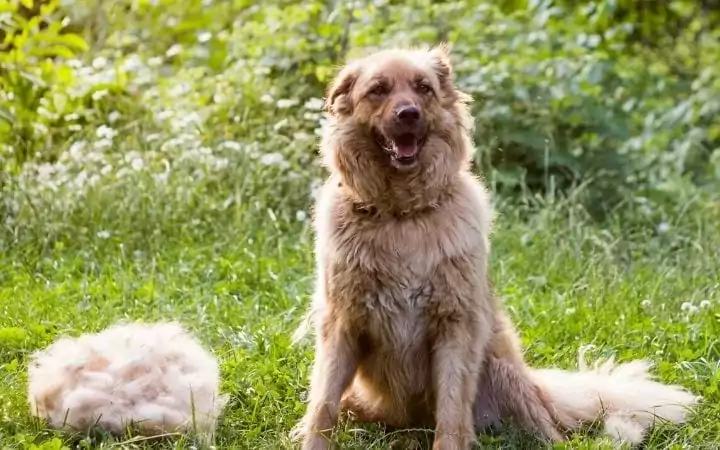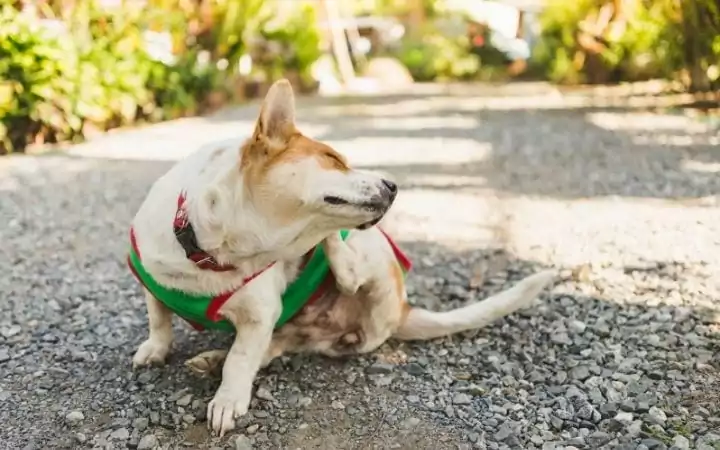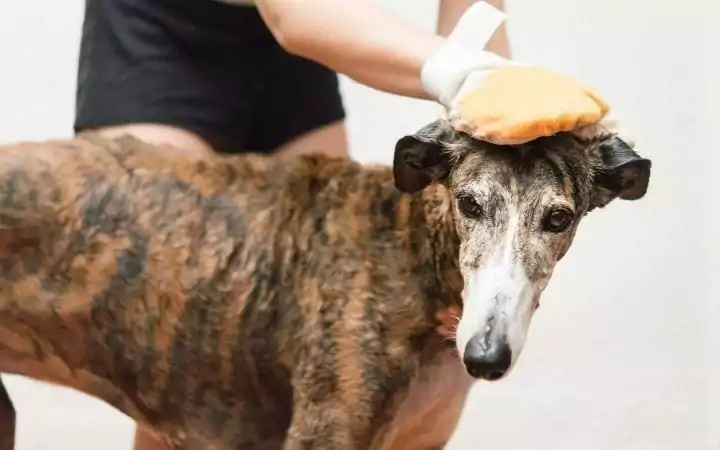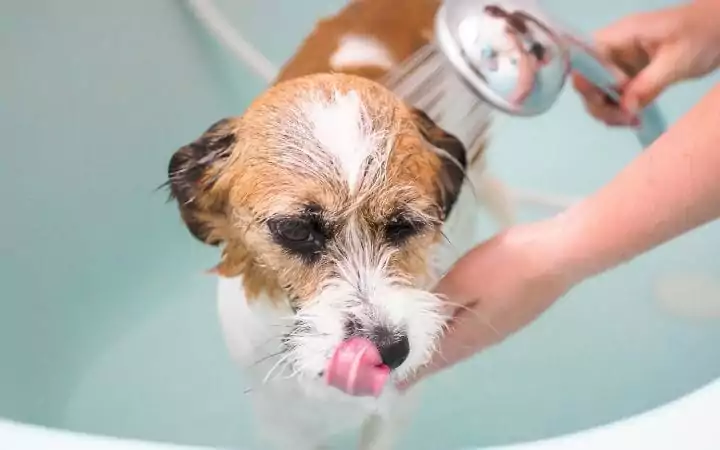As a dog parent, you have experienced the shedding cycle of your canine companion that generally happens at the start of the spring season and early autumn. Some factors can modify it, such as ambient temperature and nutrition.
The shedding process is natural and normal, and it should not be confused with the inability of hair to regrow or bald patches. In this article, we will give you everything you need to know about alopecia in dogs, including possible causes.
This blog post has just general information, and you must seek your veterinarian’s attention for a proper diagnosis and treatment.
What is Alopecia in Dogs?
Alopecia in dogs is a term used in veterinary medicine to describe hair loss when it fails to grow at a normal pace, or when there is a complete or partial absence of hair over the dog’s body.
The hair grows from the hair follicle. Alopecia occurs when this part becomes damaged or affected by an infection or inflammation or other underlying cause.

What Causes Alopecia In Dogs?
There are many causes of canine alopecia, most of them are treatable or manageable, and some are cosmetic (treatment is not necessary as it does not affect the health of the dog). Let’s look at some specific types of alopecia, and their causes:
- Post-injection alopecia: focal hair loss mostly caused by a reaction to rabies and corticosteroids injections. Often seen in small breed dogs such as Bichon Frises and Toy or Miniature Poodles. Post-injection alopecia is primarily cosmetic.
- Seasonal flank alopecia: localized cosmetic lack of hair in one or both flanks (side of the dog between the chest and hind leg) without any sign of skin disease. Seasonal flank alopecia in dogs usually occurs in the winter. Although the cause of this condition is still unknown, there are debates that it might be due to an irregular response to seasonal hormonal changes. It is mostly seen in Boxers, Dobermans, and English Bulldogs.
- Alopecia X: symmetrical alopecia around the body, usually in the trunk, tail, and neck. The skin of the dog may become darker (hyperpigmentation). The cause is not determined yet, but it is thought to be related to abnormal levels of sex hormones. Alopecia X in dogs is an uncommon cosmetic skin condition.

Alopecia in dogs is commonly acquired, meaning that this condition is developed after birth, and it is not inherited. Also, alopecia is usually a symptom of an underlying condition, including:
- Hypothyroidism: underproduction of thyroid hormones. When alopecia is thyroid-related, it will normally occur on both sides of the dog’s body.
- Demodectic mange: increase of Demodex canis parasite due to a weak immune system. A dog with demodectic mange can have specific areas with alopecia (localized) or baldness in the entire body (generalized).
- Ringworm: a fungal infection that affects the hair follicles and creates round patches of hair loss.
- Pyoderma: a common inflammatory bacterial skin infection in dogs caused by licking and scratching of a wound or cut that can result in hair loss.
- Cushing’s disease: overproduction of cortisol. Cushing’s disease can cause symmetrical hair loss over the body.
- Flea allergy dermatitis: an allergic reaction to flea saliva and can cause very itchy and irritated skin and lead to hair loss due to intensive scratching and biting.
- Seborrhea: a condition where the sebaceous glands produce too much sebum, which leads to scaly skin and an excessive amount of grease production that clogs the hair follicles.
Canine alopecia can be congenital (present from birth), but it is rare. Some cases are believed to be genetic, including pattern baldness and black hair follicular dysplasia.
- Pattern baldness in dogs is a noninflammatory type of alopecia and starts with thinning of the coat in the ears, neck, head, and chest. It is commonly seen in Dauschbunds, but there are also cases in Chihuahuas, Boston Terriers, Irish Water Spaniels, Whippets, and Bull Terriers.
- Black hair follicular dysplasia: is a rare noninflammatory skin disorder where dogs with tricolor and bicolor coats develop hair loss in black-haired areas. Black hair follicular dysplasia can affect breeds like Bearder Collies, Gordon Setters, and Saluki.
Symptoms Of Alopecia In Dogs
The most evident signs of alopecia are bald patches and thinning of the hair. Depending on the cause, it can be sudden or gradual, symmetrical, or patchy and be accompanied by inflammation, itchiness, crusts, irritation, change in skin color, dandruff, and discharge.
As mentioned before, alopecia can be a secondary indication of another disease, and if this is the case, there may be other symptoms no specific to alopecia. For example, if alopecia is related to Cushing’s disease, the dog may have symptoms such as increased appetite and intake of water, an increase in urination, lethargy, and an enlarged abdomen.

How is Alopecia in Dogs Diagnosed?
Alopecia in dogs is visible to the naked eye. The purpose of the diagnostic tests is to find the cause and rule out other conditions and illnesses.
Your vet will first take a medical history to obtain clues about the cause of hair loss. For instance, your vet may ask you if you have seen your dog scratching a lot and how long has the hair loss been present. Your vet will also ask you if your dog has been lethargic or if you have observed any other changes in behavior or appearance.
Then, your vet will conduct a physical examination to find more about the cause of alopecia. Your veterinarian may find:
- Flea dirt: sign of flea infestation
- Darkening in the skin: sign of hypothyroidism or Cushing’s disease
- Slow heart rate: symptom of hypothyroidism
- Scaly and inflamed skin: may be a sign of ringworm
Your veterinarian may also recommend different diagnostic tests, such as:
- Fungal culture and a special ultraviolet lamp called Wood’s lamp if your vet suspects ringworm
- Complete blood cell count and thyroid level for hypothyroidism
- Skin scrapping to check for mites
- Cytology and skin biopsy to look for inflammatory cells, bacteria, and other skin cells
- Bacterial culture to check for a specific type of bacteria
What Are the Treatment Options for Alopecia In Dogs?
Once the cause of alopecia is diagnosed, your veterinarian will determine the best treatment according to it.
As stated earlier, for those cases that are cosmetic like seasonal flank alopecia, treatment is not needed, and hair may regrow spontaneously, or baldness may remain. However, some tablets are used to promote hair regrow. For alopecia X, your veterinarian may recommend neutering if your dog is intact.
For parasitic and fungal infections, your veterinarian may prescribe tablets and advise a type of shampoo, creams, and ointments, along with cleaning and treating the environment.
For other causes like hypothyroidism, your vet will prescribe medication such as thyroid hormone supplementation. For Cushing’s disease, the treatment will vary on the cause.

Summary
Alopecia is a common reason for visits to a veterinary clinic. If you see that alopecia is followed by redness, itchiness, inflammation, and discharge, it is important that you seek veterinary attention for proper diagnosis.
Some types of hair loss are not preventable, but if you use flea and tick control, you will be able to avoid these kinds of alopecia. You can read HERE our recommendations for external parasite prevention, be aware that these are just suggestions, and you should consult your veterinarian for a product that will fit your dog’s situation and needs.


